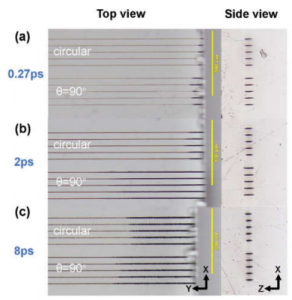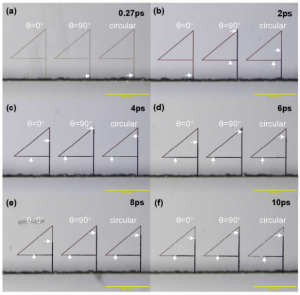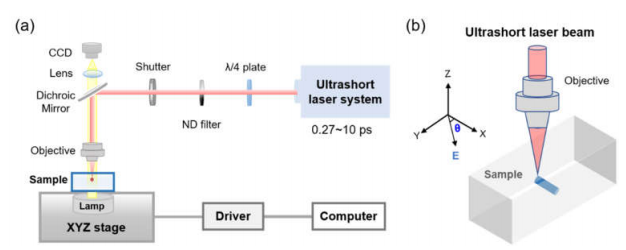Researchers Improve Femtosecond Selective Chemical Etching
In a paper entitled “Polarization-insensitive space-selective etching in fused silica induced by picosecond laser irradiation,” a group of researchers discusses space selective chemical etching, which can be achieved when fused silica is irradiated with focused femtosecond laser beams. Femtosecond lasers are a valuable tool for creating 3D microstructures in transparent materials, including glass. The technique has been used for fabricating various microfluidic devices and optical components.
In their experiments, the researchers used fused silica glass samples as processing substrates. An ultrashort laser system was used for laser direct writing.
“To evaluate the dependence of the etching rate on various combinations of pulse duration, polarization and laser power, we scanned groups of lines (each group contains five parallel lines) with a length of 10 mm and a line spacing of 50 μm under the different conditions,” the researchers state. “The five lines in each group were written under the same condition, and the measurements were performed by averaging the data obtained from the individual lines in the same group.”
 After the laser irradiation, the glass samples underwent post-processing and were then examined by optical microscopy and scanning electron microscopy.
After the laser irradiation, the glass samples underwent post-processing and were then examined by optical microscopy and scanning electron microscopy.
“The influence of pulse durations on the etching rates can be divided into two regimes: 0.27 ps (270fs) ~ 4ps and 4~10 ps. In the regime between 0.27 ps and 4 ps, one can see a strong dependence of the etching rate on the polarization of the laser beam,” the researchers explain. “The etching rates obtained with linearly polarized (R ⊥ , θ=90°) laser beams are significantly higher than that obtained with the circularly polarized laser beams (RΟ, circular) and the linearly polarized (R∥, θ=0°) laser beams. In particular, an etching rate of 766.3±22.2 μm/hour can be obtained with the linearly polarized laser beams (R⊥) at 2ps when the laser power is set at 400 mW (see Figure 1d and Table 1), which is the highest etching rate obtained in our investigation.”
The dependence of etching rate on the writing laser polarization originates from the formation of nanogratings in fused silica under repeated irradiation with ultrashort laser pulses; therefore, the researchers continue, the etching behaviors are dominated by the existence of nanogratings induced by ultrashort laser pulses.
 The etching results are very different, however, in the regime between 4ps and 10 ps. The etching rates obtained with the circularly polarized laser beams (RΟ) and the linearly polarized laser beams (R∥) greatly increase, while the rate obtained with the linearly polarized (R⊥) laser beams decreases. When the pulse duration reached 10ps, the dependence of etching rate on the writing laser polarization almost disappeared.
The etching results are very different, however, in the regime between 4ps and 10 ps. The etching rates obtained with the circularly polarized laser beams (RΟ) and the linearly polarized laser beams (R∥) greatly increase, while the rate obtained with the linearly polarized (R⊥) laser beams decreases. When the pulse duration reached 10ps, the dependence of etching rate on the writing laser polarization almost disappeared.
“To conclude, our investigations reveal a new region of interaction of ultrashort laser pulses with fused silica which does not form either smooth modification (i. e., region 1) and nanograting (i.e., region 2) or nanovoid (i.e., region 3) as reported previously,” the researchers conclude. It is shown that the picosecond laser irradiation can produce interconnected nanocracks which are preferentially oriented along the laser scan direction. The revealed characteristic is used for fabricating microfluidic channels along different directions to achieve the high etching rates insensitive to the writing laser polarization state.”
The manufacturing of microfluidic channels is complex. Currently, it often involves a lot of manual labor, fusing several different parts or a chain of technologies working together. Although early stage this picosecond approach may lead to a viable commercial technology in manufacturing microfluidics.
Authors of the paper include Xiaolong Li, Jian Xu, Zijie Lin, Jia Qi, Peng Wang, Wei Chu, Zhiwei Fang, Zhenhua Wang, Zhifang Chai and Ya Cheng.
Discuss this and other 3D printing topics at 3DPrintBoard.com or share your thoughts below.
Subscribe to Our Email Newsletter
Stay up-to-date on all the latest news from the 3D printing industry and receive information and offers from third party vendors.
Print Services
You May Also Like
New Business: Temporary, Migratory, & Modular 3D Printed Architecture
If we look at potentially emerging 3D printing businesses, then architecture has not been fully explored. Yes, there is a lot of house 3D printing going on worldwide. From deployable...
3D Printing News Briefs, April 19, 2025: Material Extrusion Standard, Metal Powder, & More
In today’s 3D Printing News Briefs, we’re covering a proposed standard for material extrusion, before moving on to business and metal powder. We’ll end with a commercial store’s robotic 3D...
Japan Unveils World’s First 3D Printed Train Station
Japan is now home to what we believe is the world’s first train station built with 3D printing technology. Located in Arida City, just south of Osaka, the new Hatsushima...
restor3d Raises $38M to Expand 3D Printed Orthopedic Implants
Backed by $38 million in new funding, restor3d is pushing ahead with the launch of four personalized implant lines, set to roll out in 2025 and 2026. This latest venture...


























